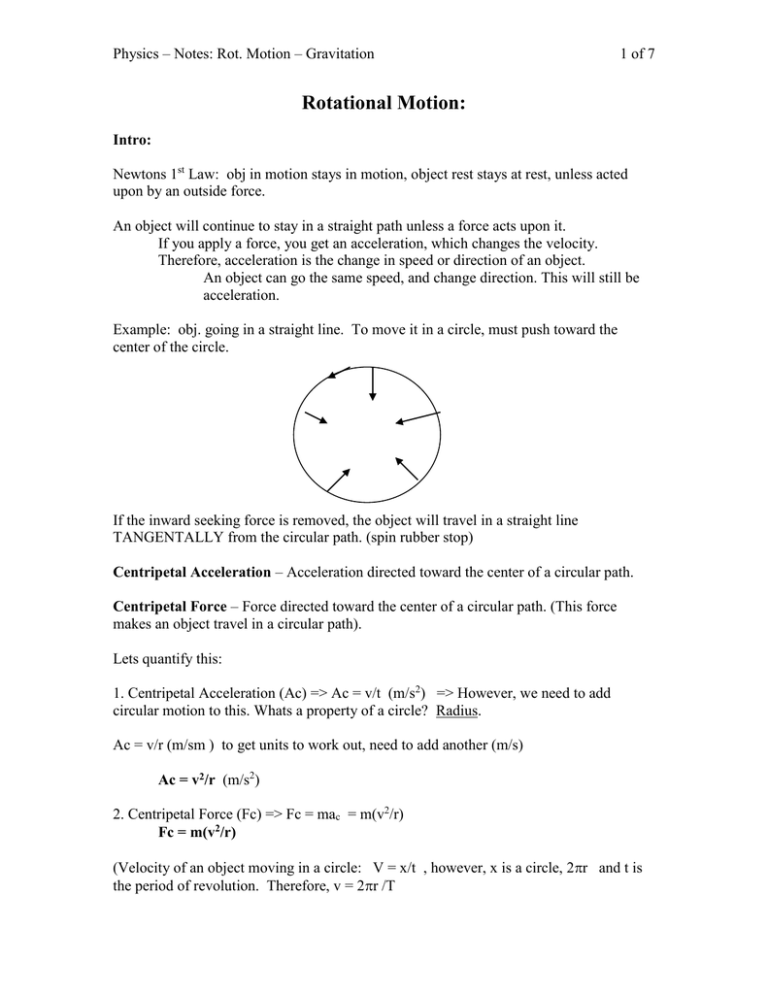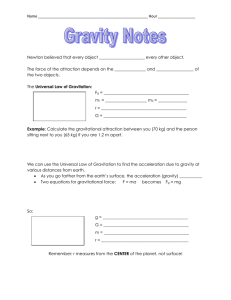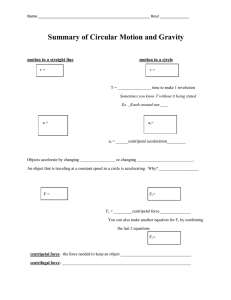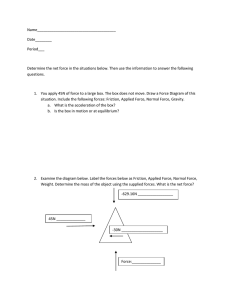Rotational Motion:
advertisement

Physics – Notes: Rot. Motion – Gravitation 1 of 7 Rotational Motion: Intro: Newtons 1st Law: obj in motion stays in motion, object rest stays at rest, unless acted upon by an outside force. An object will continue to stay in a straight path unless a force acts upon it. If you apply a force, you get an acceleration, which changes the velocity. Therefore, acceleration is the change in speed or direction of an object. An object can go the same speed, and change direction. This will still be acceleration. Example: obj. going in a straight line. To move it in a circle, must push toward the center of the circle. If the inward seeking force is removed, the object will travel in a straight line TANGENTALLY from the circular path. (spin rubber stop) Centripetal Acceleration – Acceleration directed toward the center of a circular path. Centripetal Force – Force directed toward the center of a circular path. (This force makes an object travel in a circular path). Lets quantify this: 1. Centripetal Acceleration (Ac) => Ac = v/t (m/s2) => However, we need to add circular motion to this. Whats a property of a circle? Radius. Ac = v/r (m/sm ) to get units to work out, need to add another (m/s) Ac = v2/r (m/s2) 2. Centripetal Force (Fc) => Fc = mac = m(v2/r) Fc = m(v2/r) (Velocity of an object moving in a circle: V = x/t , however, x is a circle, 2r and t is the period of revolution. Therefore, v = 2r /T Physics – Notes: Rot. Motion – Gravitation 2 of 7 Examples of Centripetal Force: 1. What keeps the rubber stop spinning in a circle? Tension of the string (If let go of string, no tension, the object flies away tangentally) 2. What keeps the earth traveling around the Sun in a circular orbit? Gravity 3. What causes a car to turn around a bend? Friction between the tires and the road (Ex: if no friction , ICE, the car will go off the road) CAR Fc Vt Centripetal vs “Centrifugal” forces Do car demo: Get in car with student: Accelerate, Decellerate, Turn (which way do you fly?) You tend to fly toward the outside of the circle, not toward the center. Why? Shouldn’t Fc push you toward the center? People call this outward force, Centrifugal force. However, it’s just inertia. Your body wants to keep going in a straight line, while the car makes a turn. Therefore, you feel like you are pushed to the outside of the car. This is the same as accelerating or decelerating. Inertia makes you feel like you are pushed foreward or backward. Do cup and Water demo Inertia keeps the water in the cup. Fc from the rope pulls cup toward center, water wants to keep going straight. Pass out Centripetal worksheet. Physics – Notes: Rot. Motion – Gravitation 3 of 7 Universal Gravitation: Intro: Johannes Kepler – 1600’s. An astronomer who analyzed the motion of the planets and developed 3 laws of planetary motion to describe the motion. With these 3 laws, anyone could predict the motion of the planets and moons in the solar system and other solar systems. - However, these were 3 LAWS. A law is only a description of nature, it does not explain it. Kepler did not know why the planets moved the way they did, he just knew how to calculate and predict their motions. There was some interaction between the sun and earth, but he did not know what it was. Isaac Newton came along – 1600’s In late 1600’s he was troubled by the lack of an explanation for the orbits of the planets. According to his 1st Law, the planets and moon should travel in a straight line. Therefore, some force must be causing them to deviate. Legend has it the he saw an apple fall, and looked at the moon. He realized it must be the same force that causes the apple to fall that causes the moon to fall toward earth. He then determined the acceleration of each object caused by this force to determine some relationship. Apple: Use simple kinematics, a – 9.8 m/s2 Moon: use rotational motion: a = v2/r V is = x/t = 2(pi)r / (period) = 2(pi)r/T Therefore, a = 4(pi)2 r / T2 Plug in the #’s, and you get .02272 m/s2 The moon had MUCH less acceleration than the apple. The moon is also MUCH farther from the earth than the apple. Based on this information, he realized the Force of gravity is inversely proportional to the distance2 Fg 1/r2 Physics – Notes: Rot. Motion – Gravitation 4 of 7 He also knew F = ma (he came up with this equation). So, F has to be proportional to m. Since there are two objects, the apple and earth or the moon and earth, he made the proportion: Fg m1 m2 Put it all together, and you get: Fg m1m2 r2 How do we get rid of the proportion symbol? Multiply by a constant of proportionality: This constant, Newton called “G” The Universal Gravitational Constant Fg = G m1m 2 r2 By doing rough calculations, Newton knew G was a TINY number, but he had no clue how to measure it. He got stuck. CAVENDISH 100 years later, mid-late 1700’s a person figured out how to measure it. Henry Cavendish. Born in Nice, France Cavendish Torsion Balance: Explain balance, use grape and magnet demo. A bar with a mass on each end. Suspended by a thin wire. When the bar rotates, the wire twists. The torque used to twist the wire can be measured. This is the Force, Fg. G = 6.67x10-11 N m2/kg2 Physics – Notes: Rot. Motion – Gravitation 5 of 7 Look at examples of Newton’s gravity equation: Example of Fg for 2 people sitting next to each other. For person standing on Earths surface (Emphasize that “r” must be measured from center to center) It’s often convenient to find the Acceleration of gravity (ag) instead of the force: Finding ag of gravity: Fg = G m1m2/r2 => Mag = G m1m2/r2 => masses cancel, ag = G M/r2 (The mass of the object cancels, we want to know the acceleration of the object falling toward earth, not earth falling toward object.) Do ag for a person on a space shuttle , airplane, and person on surface of earth. Space shuttle: 20,000 m Airplane: 30,000 ft = 9100 m On surface: 0m (R = re + altitude) Orbits: If Fg is strong, why are astronauts weightless? Look at earths surface, and zoom out, you’ll notice its round! What an Orbit Really Is The drawings at the right simplify the physics of orbiting Earth. We see Earth with a huge, tall mountain rising from it. The mountain, as Isaac Newton first envisioned, has a cannon at the top. When the cannon is fired, the cannonball follows its ballistic arc, falling as a result of Earth's gravity, and it hits Earth some distance away from the mountain. If we put more gunpowder in the cannon, the next time it's fired, the cannonball goes halfway around the planet before it hits the ground. With still more gunpowder, the cannonball goes so far that it never touches down at all. It falls completely around Earth. It has achieved orbit. Physics – Notes: Rot. Motion – Gravitation 6 of 7 If you were riding along with the cannonball, you would feel as if you were falling. The condition is called free fall. You'd find yourself falling at the same rate as the cannonball, which would appear to be floating there (falling) beside you. You'd never hit the ground. Notice that the cannonball has not escaped Earth's gravity, which is very much present -- it is causing the mass to fall. It just happens to be balanced out by the speed provided by the cannon. Getting Into Orbit The cannonball provides us with a pretty good analogy. It makes it clear that to get a spacecraft into orbit you need to Raise It Up (the mountain) to a high enough altitude so that Earth's atmosphere isn't going to slow it down too much. In practical terms you don't generally want to be less than about 100 miles above the surface of the Earth. At that altitude, the atmosphere is so thin that it doesn't present much frictional drag to slow you down. Accelerate It until it is going so fast that as it falls, it just falls completely around the planet. To get a high enough tangential velocity to achieve orbit, so that the object doesn’t fall back down. “What goes up, doesn’t necessarily come back down” m is mass of planet r is radius of planet Find Vesc for earth Find Vesc for moon Mmoon = 7.35 x1022 kg Rmoon = 1,738,000 m Physics – Notes: Rot. Motion – Gravitation 7 of 7 Pendulums (Simple Harmonic Motion) Simple Harmonic Motion (An oscillating system, spring, pendulum, etc.. has allot to do with Gravity) We are briefly going to familiarize ourselves with SHM in the form of a Pendulum. Use Bowling Ball Pendulum to show relationships below: Period (T) – Time for an object to complete 1 oscillation or cycle. List factors that affect the period of a Pendulum: Length, Acc. of Gravity, Mass, Amplitude 1. Length: the length of the string Short length – long T Long length – Short T Therefore T L 2. Acceleration of gravity (ag) – cant demonstrate this one. Bigger a, shorter T Therefore T 1/ag 3. Mass (m) – T does not depend on mass Therefore no relationship. 4. Amplitude (A) – Maximum displacement from equilibrium. T does not depend on Amplitude Therefore no relationship. THEREFORE – T L/ag To make it an “=” sign, add proportion: T = 2 sqrt(L/ag)


